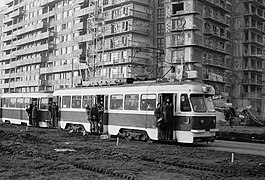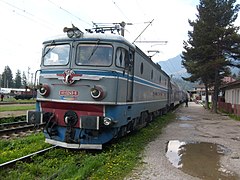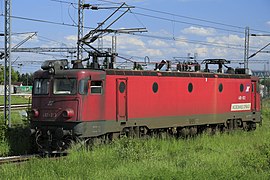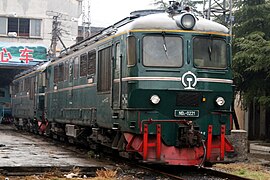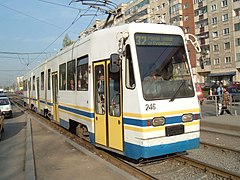Căile Ferate Române was the state railway carrier of Romania. The company was dissolved on 1 October 1998 by splitting into several successor companies. As of 2014, the railway network of Romania consists of 10,777 km (6,697 mi), of which 4,029 km (2,504 mi) (37.4%) are electrified. The total track length is 22,247 km (13,824 mi), of which 8,585 km (5,334 mi) (38.5%) are electrified. The CIA World Factbook lists Romania with the 23rd largest railway network in the world. The network is significantly interconnected with other European railway networks, providing pan-European passenger and freight services. CFR as an entity has been operating since 1880, even though the first railway on current Romanian territory was opened in 1854. CFR is divided into four autonomous companies:

Bucharest has the largest transport network in Romania, and one of the largest in Europe. The Bucharest transport network is made up of a subway network and a ground transport network. Although there are multiple connection points, the two systems operate independently of each other, and are run by different organisations (the subway is run by Metrorex and the ground transport network by Societatea de Transport București. The two companies used separate ticketing systems until 2021, when a new smartcard was introduced alongside the old tickets, which allows travel on both the STB and the Underground.

T4 is the name of a tram produced by ČKD Tatra. It is the narrower variant of the Tatra T3 model. A large number of cars was supplied to the GDR, the USSR, Romania and the former Yugoslavia using names T4D, T4SU, T4R and T4YU, respectively. The T4 was originally developed in 1968 and has been continuously modernized or copied since.

ND2 is the name for a Romanian diesel-electric locomotive, produced by Electroputere, exported to and employed in China by China Railway. It was made for the purpose of heavy transport.

The JŽ class 441 is an electric locomotive built for Yugoslav Railways. The units are now used by Hrvatske željeznice, Željeznice Federacije Bosne i Hercegovine, Željeznice Republike Srpske, Serbian Railways and Rail transport of TPP Nikola Tesla, Makedonski Železnici, Turkish State Railways and Romanian Railways-CFR.
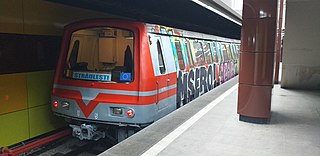
Astra IVA is a family of metro train used by Bucharest Metro, of which 504 cars were built between 1976 and 1993 by Întreprinderea de Vagoane Arad (IVA) in Arad, Romania. Internally they are known as the BM1.

FAUR S.A. is an industrial engineering and manufacturing company based in Bucharest, Romania.

The Reșița Works are two companies, TMK Reșița and UCM Reșița, located in Reșița, in the Banat region of Romania. Founded in 1771 and operating under a single structure until 1948 and then from 1954 to 1962, during the Communist era they were known respectively as the Reșița Steel Works and as the Reșița Machine Building Plant, the latter renamed in 1973 as the Reșița Machine Building Enterprise. They have played a crucial role in the industrial development both of the region and of Romania as a whole, and their evolution has been largely synonymous with that of their host city.

The JŽ series 461 is a six-axle electric locomotive built in Romania for Yugoslav Railways. Today there are known as ŽS series 461 in Serbia, ŽCG series 461 in Montenegro and MŽ series 461 with Macedonian railways.

The Electroputere LE 5100, otherwise known as CFR Class 40/41/42, is a family of electric locomotives built for the Romanian Railways (CFR) for use on the Romanian electrified network. Over 1000 Class 40s were constructed, based on the SJ Rb, by Electroputere (EP) under ASEA license in EPs Craiova Works from 1967 to 1991.
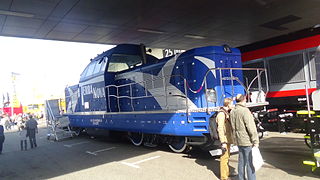
The Terra Nova locomotive is a diesel-hydraulic locomotive used mainly for heavy shunting operations and light line service. It is produced at Electroputere VFU-Reloc Craiova, Romania and it had its official launching in May 2014, having four axles and the possibility to be adapted to all types of gauges.

Transport Călători Express (TCE) is a local government body responsible for the transport system in Ploiești, Romania.

Timiș 2 were a series of tram vehicles built in Timișoara, Romania, initially by the Timișoara Transport Company, and later by Electrometal Timișoara.

The Electroputere (EP) V54 was a tram series produced by Electroputere of Craiova, in the (then) People's Republic of Romania in the 1950s, with a total of 265 units built, excluding the 37 units of the earlier V951 Festival tramcars, produced by URAC Bucharest. Inspired by the PCC streetcar, the name comes from the Romanian "Vagon 54", translated to as "Tramcar model year 1954".

The Bucharest Articulated Tramcar series is a series of tram vehicles produced between 1971 and 1992 by URAC, the main workshops of the Bucharest Transit Company. Various modernized variants have also been delivered since 1993. For the last 50 years they have been the backbone of the tram network in Bucharest, replacing motor-trailer formations that had run in the city since the introduction of electric trams.

The CFR Class TEA was a small series of Electric Multiple Units (trains) manufactured in Romania from 1974 to 1986 for Căile Ferate Române. Due to its rarity, not much is known about this trainset, albeit a technical sheet designed for potential export does exist online.

OSE class A.551 was a class of diesel locomotives, which were used to be a part of Hellenic Railways Organization (OSE)'s rolling stock. It was built in 1982 by Electroputere in Craiova, Romania, by OSE's order. It was usually coupled with a heating coach, for the train's heating needs. In total, 10 units were produced, numbered A.551 to A.560, which had an Alco 251R/V16 engine, with a 2,911-kilowatt power output, and were capable to reach speeds up to 145 kilometres per hour (90 mph).

